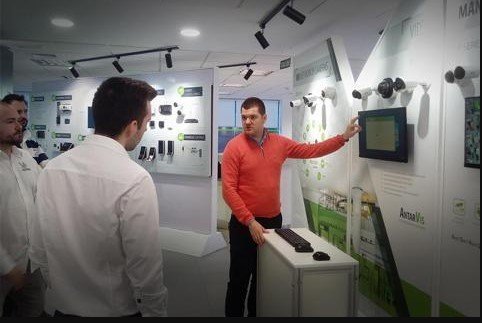Setting up for training with CCTV (Closed-Circuit Television) involves multiple steps, especially if you’re using CCTV footage for training purposes, such as for machine learning models, security training, or monitoring system training. Here’s a general guide to help you through the process:
1. Define Objectives
- Purpose: Identify the purpose of using CCTV footage (e.g., security training, behavior analysis, machine learning model training).
- Specific Goals: Define specific goals, such as identifying suspicious behavior, facial recognition, object detection, etc.
2. Select CCTV Cameras
- Camera Quality: Choose cameras with the appropriate resolution, frame rate, and field of view.
- Camera Placement: Position cameras to cover all necessary areas with minimal blind spots.
- Storage Capacity: Ensure adequate storage for recorded footage, depending on the duration and quality.
3. Set Up the CCTV System
- Install Cameras: Mount cameras securely and ensure they are powered and connected to the network.
- Configure Network: Set up a secure network for data transmission, considering encryption and firewalls.
- Connect to Recording Device: Use a DVR (Digital Video Recorder) or NVR (Network Video Recorder) to store footage.
4. Footage Management
- Storage: Use cloud-based or local storage solutions, depending on data sensitivity and storage needs.
- Backup: Implement regular backup routines to prevent data loss.
- Access Control: Set up permissions to ensure only authorized personnel can access footage.
5. Data Labeling and Annotation (for Machine Learning)
- Data Collection: Gather relevant footage for training purposes.
- Annotation Tools: Use tools to label and annotate the footage, marking objects, faces, or behaviors of interest.
- Dataset Preparation: Organize labeled data into a structured format (e.g., CSV, JSON) for model training.
6. Training and Testing (for Machine Learning)
- Model Selection: Choose an appropriate algorithm for training (e.g., CNN for image recognition).
- Training: Use annotated footage to train your model, optimizing for accuracy.
- Testing: Evaluate the model using a separate dataset or live footage to ensure accuracy and reliability.
7. Security Training (for Security Personnel)
- Scenario Simulations: Use recorded footage to simulate real-life scenarios for training security personnel.
- Evaluation: Assess the trainees’ responses and decision-making skills in various situations.
8. Legal and Ethical Considerations
- Compliance: Ensure compliance with local laws regarding surveillance and data privacy.
- Consent: Obtain necessary consent from individuals if required, especially if footage is used for training purposes.
9. Monitoring and Evaluation
- Regular Review: Continuously monitor the system and update training protocols based on new footage or insights.
- Feedback Loop: Incorporate feedback from training sessions to improve the CCTV setup and training programs.
10. Documentation and Reporting
- Training Logs: Keep records of training sessions, including footage used, outcomes, and participant feedback.
- System Documentation: Document the CCTV system setup, including network configuration, camera placement, and security measures.
By following these steps, you can effectively set up a CCTV system for training purposes, whether for security training, machine learning, or other specialized uses.
Certainly! Let’s dive deeper into the specific steps and considerations for setting up and utilizing CCTV for training purposes.
1. Advanced Camera Selection and Setup
- Camera Types:
- Fixed Cameras: Suitable for monitoring specific areas continuously.
- PTZ (Pan-Tilt-Zoom) Cameras: Can be remotely controlled to focus on different areas, zoom in/out, and rotate.
- Thermal Cameras: Useful in low-light conditions or for detecting heat signatures.
- IP Cameras: Network-based cameras that offer high-quality video and can be easily integrated into existing IT infrastructure.
- Field of View: Choose cameras with the appropriate lens (wide-angle for large areas, narrow for focused spots).
- Lighting Considerations: Install appropriate lighting, especially in low-light areas, or use cameras with night vision capabilities.
- Weatherproofing: For outdoor cameras, ensure they are weather-resistant and can withstand local environmental conditions.
2. Network and Storage Infrastructure
- Network Bandwidth: Ensure your network can handle the data load from multiple high-resolution cameras, especially if streaming in real-time.
- Storage Solutions:
- On-Site Storage: Use DVRs or NVRs with large hard drives. RAID setups can offer redundancy.
- Cloud Storage: Useful for remote access and redundancy, though it requires a stable internet connection.
- Hybrid Storage: Combines on-site and cloud storage for more flexibility and security.
- Compression Techniques: Use video compression (e.g., H.264, H.265) to reduce storage needs without significantly compromising quality.
3. Data Privacy and Security
- Encryption: Encrypt video streams and stored footage to protect against unauthorized access.
- Access Control: Implement role-based access control (RBAC) to restrict who can view, download, or manage footage.
- Regular Audits: Conduct periodic security audits to ensure compliance with data protection regulations and internal policies.
- Anonymization: When using footage for training, consider anonymizing or blurring faces to protect individual privacy, unless facial recognition is part of the training.
4. Advanced Data Labeling and Annotation
- Annotation Software:
- Manual Annotation: Use tools like LabelImg, CVAT (Computer Vision Annotation Tool), or VGG Image Annotator for detailed manual labeling.
- Semi-Automated Tools: Tools that use AI to suggest annotations, which can be corrected by a human, speeding up the process.
- Crowdsourced Labeling: Use platforms like Amazon Mechanical Turk for large-scale labeling tasks.
- Labeling Strategies:
- Object Detection: Label objects of interest, such as vehicles, people, or specific items (e.g., packages).
- Action Recognition: Label sequences of actions or behaviors (e.g., running, fighting, loitering).
- Event Detection: Annotate specific events, such as theft, accidents, or unauthorized entry.
- Consistency: Establish clear guidelines for labeling to ensure consistency across your dataset, which is crucial for model accuracy.
5. Model Training and Optimization
- Data Preprocessing:
- Normalization: Standardize video inputs (e.g., resizing, color normalization) for consistent model training.
- Augmentation: Use techniques like flipping, rotation, and scaling to artificially increase the size and diversity of your dataset.
- Splitting Data: Divide data into training, validation, and test sets to evaluate model performance effectively.
- Model Selection:
- Convolutional Neural Networks (CNNs): Ideal for image and video data, commonly used in object detection and classification.
- Recurrent Neural Networks (RNNs): Useful for sequential data, like recognizing actions over time in video footage.
- Transfer Learning: Use pre-trained models (e.g., YOLO, Faster R-CNN) and fine-tune them on your specific CCTV footage to save time and computational resources.
- Training Techniques:
- Hyperparameter Tuning: Experiment with different learning rates, batch sizes, and architectures to optimize model performance.
- Cross-Validation: Use k-fold cross-validation to assess model generalization and reduce overfitting.
- Continuous Learning: Update the model with new data periodically to improve accuracy and adapt to changes in the environment.
6. Scenario-Based Security Training
- Simulation Scenarios:
- Routine Monitoring: Train personnel on daily monitoring activities, recognizing normal vs. abnormal behaviors.
- Emergency Response: Simulate emergencies, like fire, intruder alerts, or medical emergencies, and train personnel on appropriate responses.
- Suspicious Activity Recognition: Use pre-recorded footage to train on identifying loitering, unauthorized entry, or potential theft.
- Interactive Training:
- Live Drills: Conduct live drills where trainees respond to real-time simulated scenarios, allowing them to apply their skills in a controlled environment.
- Feedback Sessions: Review footage from training drills to provide constructive feedback and identify areas for improvement.
- Performance Metrics:
- Response Time: Measure how quickly personnel respond to incidents.
- Accuracy: Evaluate the correctness of decisions made during scenarios.
- Adaptability: Assess how well trainees adapt to unexpected changes in the scenario.
7. Legal Compliance and Ethical Considerations
- Legal Framework:
- GDPR Compliance: If in the EU or dealing with EU citizens, ensure CCTV usage complies with GDPR, focusing on data minimization, consent, and the right to access.
- Local Surveillance Laws: Adhere to national and local laws governing surveillance, which may dictate where cameras can be placed and how long footage can be stored.
- Ethical Usage:
- Transparency: Clearly communicate to all stakeholders (employees, visitors) the presence of CCTV and its purposes.
- Avoiding Bias: When training AI models, ensure that the dataset is diverse to avoid biases, especially in facial recognition or behavioral analysis.
- Fair Usage: Ensure that footage is used fairly and not for unauthorized or unethical purposes.
8. System Maintenance and Monitoring
- Regular Maintenance:
- Camera Calibration: Regularly check and calibrate cameras to maintain image quality and ensure correct alignment.
- Firmware Updates: Keep camera firmware and associated software up-to-date to protect against vulnerabilities.
- System Health Monitoring: Use tools to monitor system health (e.g., camera uptime, storage usage) and alert on issues.
- Performance Review:
- Footage Review: Periodically review footage to ensure cameras are capturing the desired views and that the system is functioning as expected.
- Model Performance: Continuously monitor and review AI models’ performance and retrain as necessary to maintain accuracy.
9. Scalability and Future Expansion
- Scalable Architecture:
- Modular Setup: Design the CCTV system in a modular way, allowing for easy addition of new cameras or storage as needed.
- Cloud Integration: Consider integrating cloud services for scalable storage and advanced analytics capabilities.
- Integration with Other Systems:
- Alarm Systems: Integrate CCTV with existing alarm systems for automated responses to detected events.
- Access Control: Connect CCTV with access control systems to track and record entry and exit points.
- AI Analytics: Integrate advanced AI analytics for real-time alerts and predictive analysis (e.g., predicting crowd behavior).
10. Continuous Improvement and Adaptation
- Feedback Mechanisms:
- User Feedback: Gather feedback from security personnel, trainees, and other stakeholders to identify weaknesses in the system.
- Incident Analysis: After incidents, analyze CCTV footage to learn and adapt training protocols or system setups.
- Updating Training Modules:
- Real-Time Scenarios: Incorporate real-world incidents into training modules to keep the training relevant and up-to-date.
- Adaptive Learning: Use AI-driven adaptive learning systems that adjust training content based on the trainee’s performance.
By addressing these detailed aspects, your CCTV setup can be robust, flexible, and effective for training purposes, whether for security personnel, AI model training, or any other specialized applications.

